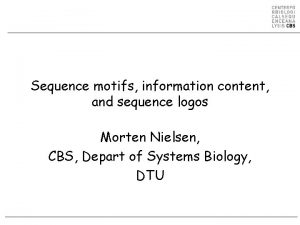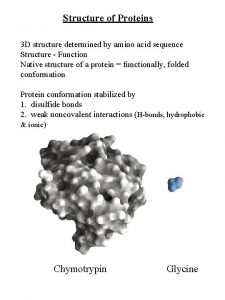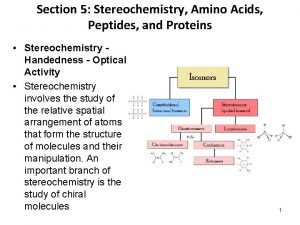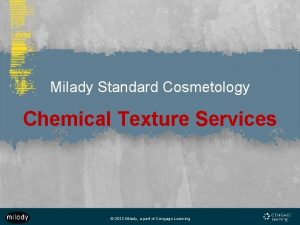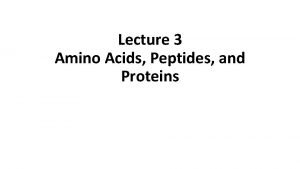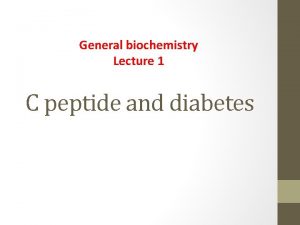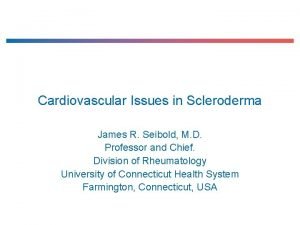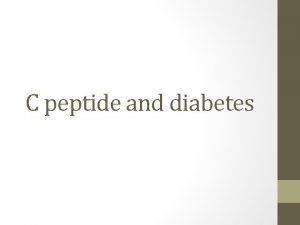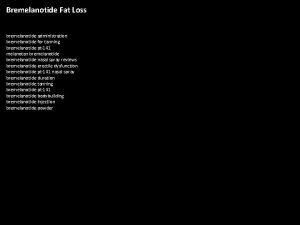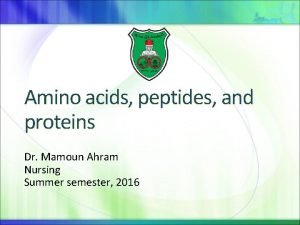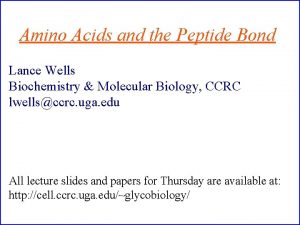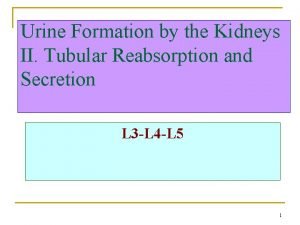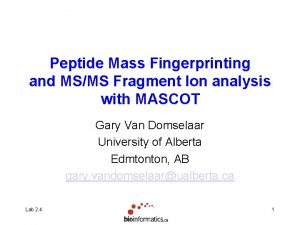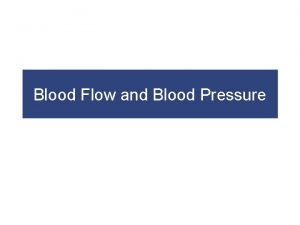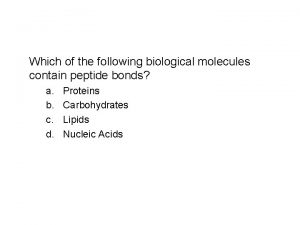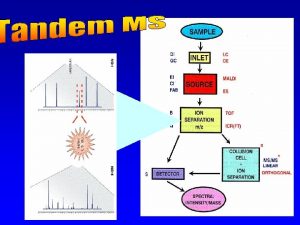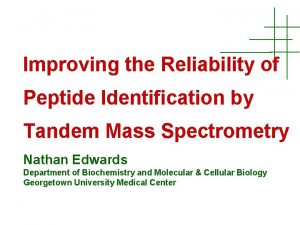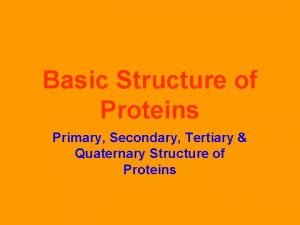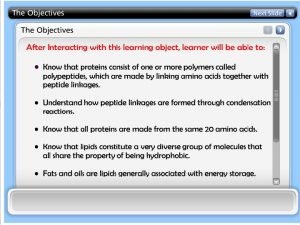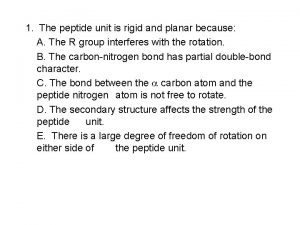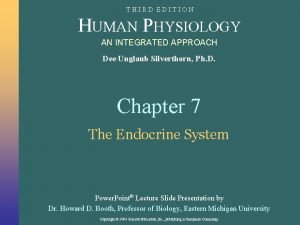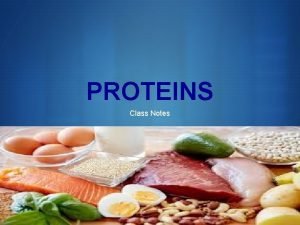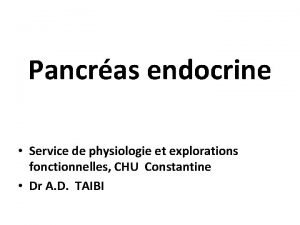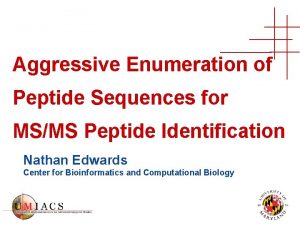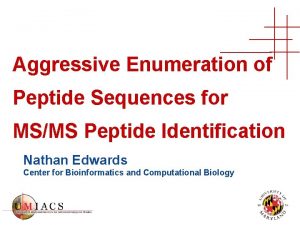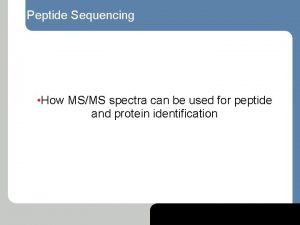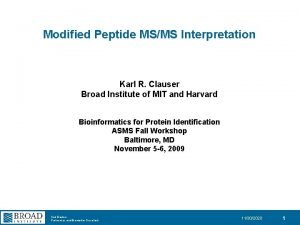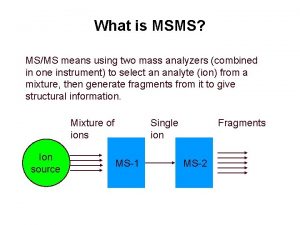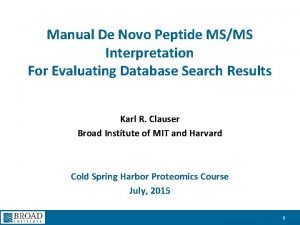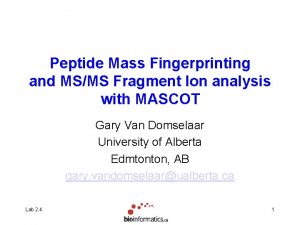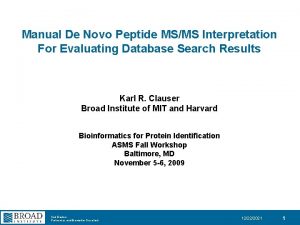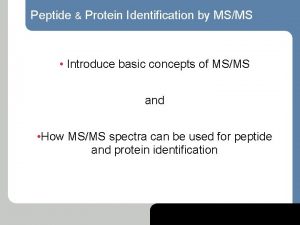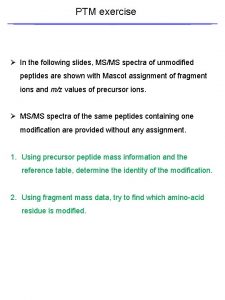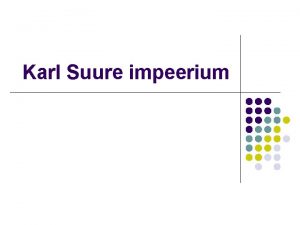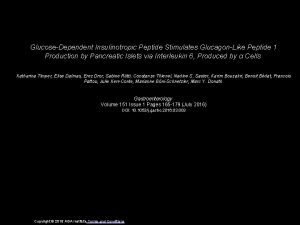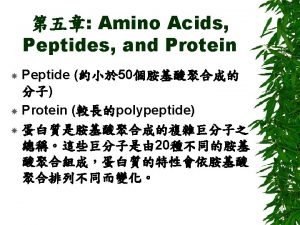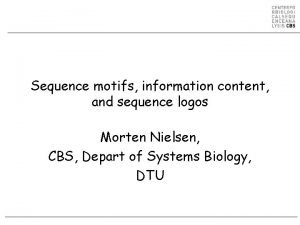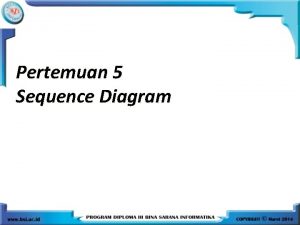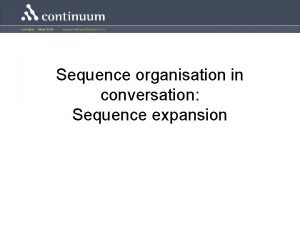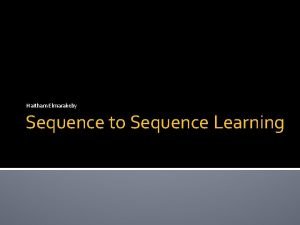Sequence Information Content in Peptide MSMS Spectra Karl



























- Slides: 27

Sequence Information Content in Peptide MS/MS Spectra Karl R. Clauser Broad Institute of MIT and Harvard Bio. Info. Summer 2012 University of Adelaide December, 2012 1

Topics Covered • • • AA properties Fragmentation pathways and ion types b/y pairs Non-mobile proton Neutral loss ion types CID/HCD/ETD Sample handling chemistry artifacts Isobaric co-eluters Mass tolerance units and isobaric AA’s Other Tutorials 2

AA Structures & Masses p. K: 10 p. K: N-term 7. 5 6 p. K: C-term 3. 5 p. K: 4. 0 4. 5 12 K H R 128 137 156 D E 115 129 S T Y 87 101 163 N Q 114 128 L I 113 G A V 57 71 99 P 97 M C 131 103 (+57 IAA) Name Gly Ala Ser Val Thr Leu/Ile Asn Asp Lys/Gln Glu Met His Phe/Met-ox Arg Cys-IAA Tyr Trp AA G A S V T L/I N D K/Q E M H F/m R C Y W Mass 101 113 114 115 128 129 131 137 147 156 160 163 186 F W 147 186 http: //ionsource. com/Card/clipart/aaclipart. htm 3

Charge-directed Fragmentation Scheme O H 2 N CH O C NH R 1 CH C NH R 2 R 3 b ion formation O O R 2 H CH C + Neutral pumped away by vacuum system Proton Mobility Mobile: zpre > #Arg + #Lys + #His Partially mobile: zpre < #Arg + #Lys + #His and > #Arg Non-mobile: zpre < #Arg OH R 4 y ion formation O R 3 z. Hz+ O and/or b 3 H 2 N CH C NH CH C + R 1 CH O + C NH H O + NH CH H R 4 C OH y 1 + Neutral pumped away by vacuum system For peptides with non-mobile protons, fragmentation tends to proceed via charge-remote mechanisms. MS/MS spectra will be dominated by a few ions, typically: C-term side of D, E N-term side of P 4

Sequence Specific Fragment Ion Types a 3 O H 2 N CH C R 1 O NH CH C b 3 c 3 O NH R 2 CH C n. Hn+ O NH R 3 CH C OH R 4 x 1 y 1 z 1 Ion type restrictions residues delta a-NH 3 contains NH 3 residue RK NQ -17 b-NH 3, y-NH 3 contains NH 3 residue RK NQ -17 b-H 2 O, y-H 2 O contains H 2 O residue ST DE -18 st -98 b-H 3 PO 4, y-H 3 PO 4 contains H 3 PO 4 residue y++, b++ contains charged residues RHK 5

Immonium ions O H 2 N CH R 1 C O NH CH C O NH R 2 Amino Acid m/z S Ser 60 V Val 72 T Thr 74 I, L Leu, Ile 86 N Asn 87 D Asp 88 K, Q Lys, Gln 84, 101, 129 E Glu 102 M Met 104 H His 110 R Arg 70, 73, 87, 100, 112, 185 F Phe 120 P Pro 70, 126 C C-iodoacetamide 133 Y Tyr 136 W Trp 117, 130, 159, 170 CH R 3 C n. Hn+ O NH CH C OH R 4 Provide partial AA composition, but not stoichiometry 6

Complementary Ions b/y pairs 128 99 99 128 E V Q L V|E/S|G|G|G L|V|K|P G GSLR 7

Dual Picket Fence 163 113 71 101 115 101 71 113 163 A E/D|T|A|L|Y|Y|C AK 8

Uniqueness of a Peptide Sequence Clauser, K. R. ; Baker, P. R. ; Burlingame, A. L. " Role of Accurate Mass Measurement ( +/- 10 ppm) in Protein Identification Strategies Employing MS or MS/MS and Database Searching", Anal. Chem. 1999, 71, 2871 -2882. 9

Dominant Cleavage Proline N-side 28 87 97 b 2 N F|P/S/P V D A A F R y 9 10

Sparse Dominant Fragmentation 202 115 202 (K)I S R|P G D|S D|D|S R(S) Non-mobile proton zpre < #Arg 11

Cry Babies (b-H 2 O & b pairs) -18 Da P(m/z)-2 H 2 O P(m/z)-H 2 O N-term E E/H/A|V/E|G/D|C D|F Q L L K 12

Orbitrap Elite, High Resolution MS/MS by CID, HCD, or ETD Precursor Isolation for each Dissociation by CID or ETD Dissociation by HCD Mass Analyzer for each Fluoranthene for ETD CID by resonant excitation <2 e. V HCD beam-type collisions with N 2 ~100 e. V ETD electron transfer dissociation CID /ETD 1/3 precursor m/z cut-off HCD, no cutoff for Separation in space of precursor isolation and fragmentation http: //planetorbitrap. com/orbitrap-elite 13

CID/HCD/ETD triplets on same precursor z=3 CID HCD (K)K/I/S/N I R E M L|P/V LE|AVAK(A) (K)K|I/S N I R E M L|P|V|LE|A V/A/K(A) (K)K/I/S/N|I|R|E|ML P V L|E|A VAK(A) ETD 14

CID/HCD/ETD triplets on same precursor z=2 (K)V S/I/P/V|I|S/D E/E|C/Q S R(F) (K)V SI/P|V/I/S/D E/E/C Q/S/R(F) CID (K)V/S/I P/V/I/S/D E/E C/Q SR(F) HCD ETD 15

CID/HCD/ETD triplets on same precursor CID z=4 (K)Q R V T G L|D|F|I|P/G L H P I L S K(M) (K)Q R V T GLDF|I/P/G L/H/P I L/S K(M) (K)Q/R|V|T|G|L|D|F/I PG|LH P|IL|S|L|SK(M) HCD ETD 16

ETD doesn’t work well at high m/z (K)A G/K/P L/L|I|I|A/E/D V E G E A L A T L V V N T M R G I V K V A A V K A P G F G D/R R K(A) (K)A G/K/P L L/I|I|A/E/D V E/G E A L A T L V V N T M R G I V K V A A V K A P G F G D R R K(A) CID HCD ETD 17

Source of Incorrect MS/MS Interpretations Major Database Peptide not in database. Mutation. MS/MS not from a peptide. Unanticipated Protein Chemistry Chemical modification, post-translational modification. Enzyme/Ion Source Non-specific cleavage. In-source fragmentation yields MS 3. Minor Algorithm Fragment ion types of instrument not accounted for. Peak Detection. Instrument Resolution Wrong parent charge. Wrong fragment charge. User Competence Wrong parameters selected. 18

Expect Woes & Nuisances Sample Handling Chemistry • Carbamylation • Deamidation • pyro. Glutamic acid • pyro. Carbamidomethyl Cys • Oxidized Met • Cys alkylation reagent +43 +1 -17 +16 +x nterm, Lys N -> D nterm Q nterm C M n-term, W urea in digest buffer sample in acid gels Data Dependent Acquisition Parameters • Isobaric Co-eluters Protein Isoforms / Family Members • Isobaric peptides from related proteins 19

Stinkers (b-NH 3) & Pyroglutamic Acid (R)Q L/Q/L/A|Q/E/A|A QK(R) P(m/z)-NH 3 N-term Q (R)q L/Q|L|A|Q|E|A|AQK(R) -17 Da Q to q 20

G S/E/S|G|I|F|T|nT K Deamidation 18. 35 96. 9% +0. 007 Da G S/E/S|G|I|F|T|DT K G S/E SGIFTN/T K 6. 62 43. 4% +0. 986 Da 21

Deamidation of Asn (+1 Da) Asn –NH + O = Asp ionsource. com 22

Know Your Chromatographic Peak Widths (K)E E m E S A E G|L|KG P/mK(S) Top Database Search Result 8. 78 71. 0% DFwd. Rev: 3. 49 Merged 4 spectra same precursor 50 sec window different peptides 23

Physiochemical Complications to Computational Interpretation • Incomplete Fragmentation • Inconsistent intensity of fragment ion types • Instrument type dependent • Amino acid dependent • Chemical or post-translational modifications • Isobaric AA’s • I = L (C 6 H 11 N 1 O) • K = Q (C 6 H 12 N 2 O, C 5 H 8 N 2 O 2) • Isobaric AA combinations • GG=N (C 4 H 6 N 2 O 2 , C 4 H 6 N 2 O 2) • GA=K=Q (C 5 H 8 N 2 O 2, C 6 H 12 N 2 O, C 5 H 8 N 2 O 2) • W=DA=VS (C 11 H 11 N 2 O, C 7 H 10 N 2 O 4, C 8 H 14 N 2 O 3) • Parent charge uncertainty • Fragment charge uncertainty 24

Consequences of Inappropriate Tolerance Units (using Da tolerance when instrument errors are in ppm) Da mass error analyzers: ion trap, quadrupole ppm mass error analyzers: time-of-flight, orbitrap, ion cyclotron resonance Too loose Too tight just right • Isobaric AA’s • I = L (C 6 H 11 N 1 O) = 113. 08406 • K ~ Q (C 6 H 12 N 2 O, C 5 H 8 N 2 O 2) 128. 09496 ~ 128. 05858 D =0. 03638 • F~m (C 9 H 9 N O, C 5 H 9 N O S) 147. 06841 ~ 147. 0354 D =0. 0330 • Isobaric AA combinations • GG=N (C 4 H 6 N 2 O 2 , C 4 H 6 N 2 O 2) 114. 04293 • GA=Q~K (C 5 H 8 N 2 O 2, C 6 H 12 N 2 O) 128. 09496 ~ 128. 05858 D =0. 03638 • DA~W~VS (C 7 H 10 N 2 O 4, C 11 H 11 N 2 O, C 8 H 14 N 2 O 3) 186. 06405 ~ 186. 07931 ~ 186. 10044 D =0. 01526 D =0. 02113 25

Additional Resources Google: “de novo sequencing tutorial” Don Hunt and Jeff Shabanowitz - manual http: //www. ionsource. com/tutorial/De. Novo. TOC. htm Rich Johnson - manual http: //www. abrf. org/Research. Groups/Mass. Spectrometry/EPosters/ms 97 quiz/Sequencing. Tutorial. html PEAKS - automated http: //www. bioinformaticssolutions. com/peaks/tutorials/denovo. html http: //www. youtube. com/watch? v=lyhp. Ru 6 s 7 Ro Bin Ma and Richard Johnson Tutorial article http: //www. broadinstitute. org/~clauser/CSHL_Proteomics_course/ Ma B, Johnson R. “De Novo Sequencing and Homology Searching”. Mol Cell Proteomics 11: 10. 1074/mcp. O 111. 014902, 1– 16, 2012. 26

Acknowledgements Broad Institute Terri Addona Namrata Udeshi Philipp Mertins Steve Carr MIT Drew Lowery Majbrit Hjerrld Michael Yaffe University of California San Diego Adrian Guthals Nuno Bandeira University of Queensland David Morgenstern Eivind Undheim Glenn King 27
 Sciex
Sciex Msms icys
Msms icys L/c
L/c Sequence logo information content
Sequence logo information content Carrier content vs real content
Carrier content vs real content Static content vs dynamic content
Static content vs dynamic content Peptide bonds in primary structure of protein
Peptide bonds in primary structure of protein Example of denatured protein
Example of denatured protein Chemical services cosmetology
Chemical services cosmetology Peptide synthesis
Peptide synthesis Elevated c peptide
Elevated c peptide Nt pro brain natriuretic peptide
Nt pro brain natriuretic peptide Low c peptide
Low c peptide Buy bremelanotide nasal spray
Buy bremelanotide nasal spray Peptide bond importance
Peptide bond importance Lance wells
Lance wells Sodium reabsorption
Sodium reabsorption Mascot peptide mass fingerprint
Mascot peptide mass fingerprint Atrial natriuretic peptide
Atrial natriuretic peptide What biological molecules contain peptide bonds
What biological molecules contain peptide bonds Peptide identification
Peptide identification Peptide identification
Peptide identification Primary vs secondary vs tertiary vs quaternary structures
Primary vs secondary vs tertiary vs quaternary structures Peptide bond
Peptide bond Peptide bond rigid and planar
Peptide bond rigid and planar Peptide hormone receptors
Peptide hormone receptors Peptide
Peptide Peptide c insuline
Peptide c insuline



